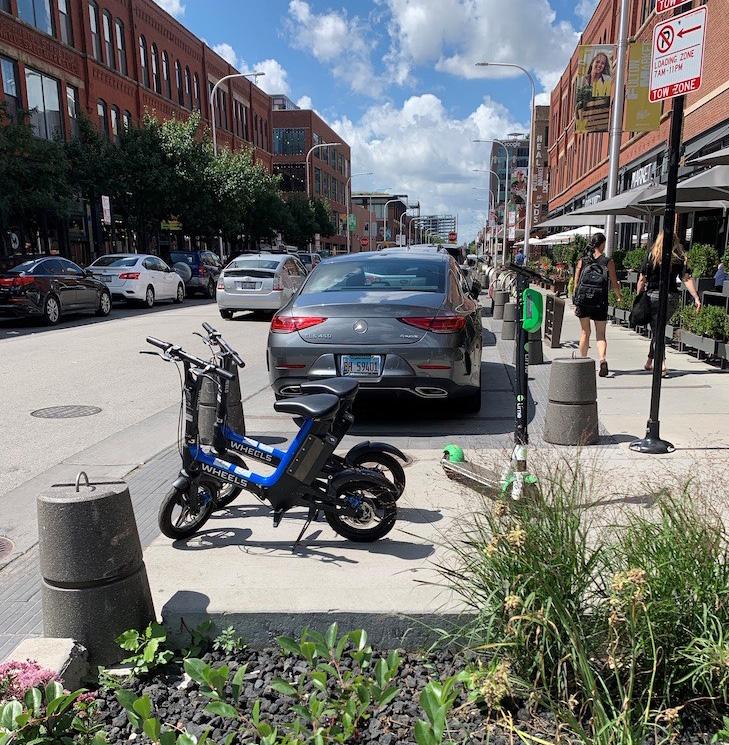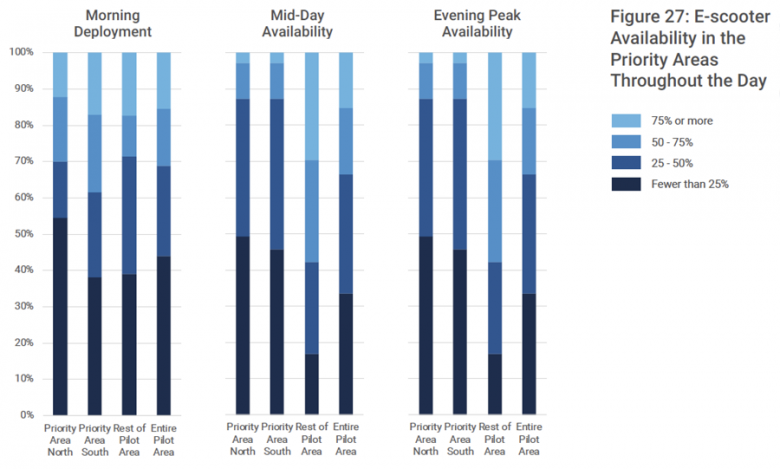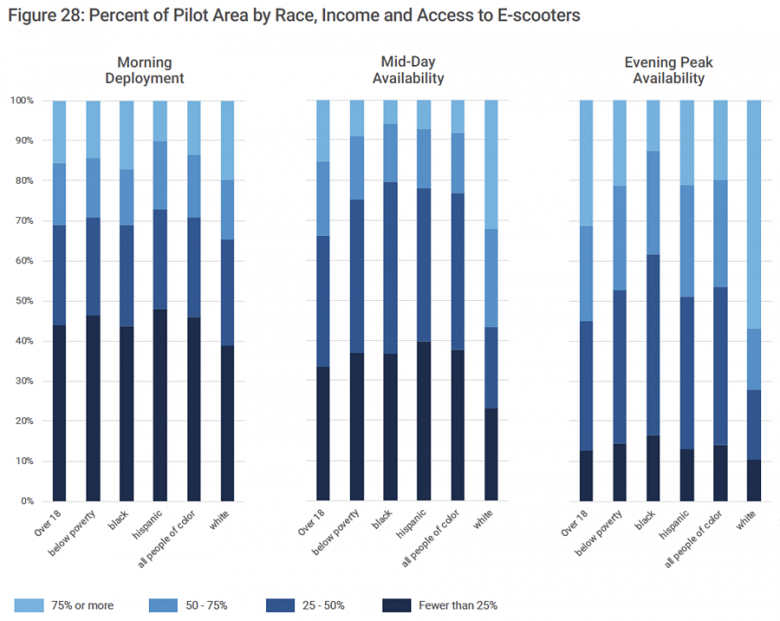Today, the City of Chicago released an evaluation of the city’s e-scooter pilot. The program, which ran from June 15th to October 15th 2019 within a designated area on the west and northwest sides, involved 10 e-scooter providers, over 800,000 reported rides, and was intended to evaluate whether e-scooters could enhance the sustainability, equity, and safety of the city’s transportation system.
CNT applauds the City of Chicago’s commitment to rigorous analysis and community engagement to understand how scooters affect equitable and sustainable transportation in the city. The evaluation identifies important lessons learned, for Chicago and other cities around the country, as they work to ensure that new transportation services improve mobility for those who need it most. CNT was excited to partner with the city on portions of the technical analysis, particularly assessment of some key questions related to whether scooters were equitably available, and how they affected people’s travel choices. Many cities have used e-scooter trip data and rider surveys to assess pilot programs, but Chicago’s evaluation also leverages ride hailing and bike share data to uncover new insights.
 E-Scooter Pilot Evaluation
E-Scooter Pilot Evaluation
The Center for Neighborhood Technology provided in-depth analysis of scooter utilization data to assist the city in assessing the performance of e-scooters in conjunction with riders’ characteristics and behaviors and evaluating whether e-scooters can provide a sustainable, safe and equitable method of transportation for residents.
Did scooters enhance transportation equity?
New transportation modes and services provide opportunities to make our transportation system more equitable. An equitable transportation system is more than just one that provides equal access to new transportation options. It should actively reduce mobility barriers faced by Chicago’s Black and Brown residents. Assessment of scooter availability and ridership reveals that there is more work to do.

Consistent with the experience in other cities, e-scooter riders were more likely to be white, male, higher income, and more educated than the population of the pilot area as a whole. However, there is some evidence that e-scooters are filling a mobility gap. Riders who reported using scooters daily were the most diverse group of survey respondents.
The city required all scooter companies to distribute 50% of their fleet within two designated priority areas each morning. These priority areas have more non-white and low income residents than the eastern half of the pilot area. The city also required companies to provide options for people to use scooters without smart phones or credit cards, but use of these programs was extremely limited.
This redistribution requirement did reduce disparities in scooter availability, at least in the morning. About 15% of the population of in each section of the pilot area nearly always had a scooter available in the morning, while 45% of the population rarely had one nearby. However, disparities emerge later in the day, as scooters move from the priority areas into the eastern section of the pilot area. By the evening rush, 60% of the residents of the eastern half of the pilot area had scooters reliably available, compared to 6% in Priority Area North, and 3% in Priority Area South.

These same dynamics are visible in data on availability by race and ethnicity. Racial disparities are smallest in the morning deployment, when 20% of white residents, 17% of Black residents, and 10% of Hispanic/Latino residents had scooters reliably available. By the evening rush, 57% of white residents had scooters reliably available, compared to 13% of Black residents and 21% of Hispanic residents.

Did scooters reduce vehicle use and greenhouse gas emissions?
E-scooters have the potential to reduce vehicle miles traveled (VMT) and greenhouse gas emissions to the extent that they shift travel from cars to active modes of transportation. As in other pilots around the country, survey respondents indicated that they were most likely to use scooters to replace ride hailing or personal car trips. When asked to think about their last e-scooter ride, nearly 43 percent of Chicago survey respondents reported that if an e-scooter had not been available, they would have either used a ride-hailing service or driven a personal vehicle.
Assuming the mode shift information in the survey is correct, the e-scooter pilot may have eliminated 179,251 vehicle trips and as many as 300,000 miles of vehicle travel, which translates to approximately 116 tons of CO2. At the same time, the pilot could have generated as many as 191,000 new active transportation trips, including trips that people would not have taken at all but for e-scooters.
However, analysis of ride hailing data submitted to the City indicates that user surveys are likely overestimating the degree to which e-scooters are replacing ride hailing trips. Comparing ride hailing trips taken within the pilot area and in the city as a whole during the pilot period (June 15-October 15 2019) to the same time period in 2018 as well as to equivalent lengths of time in spring 2019 and 2018 doesn’t show a significant change in ride hailing use that can be attributed to scooters.
If 30 percent of e-scooter trips replaced ride hailing trips, per the online survey results, all else being equal we’d expect fewer ride hailing trips in 2019 versus the same period in 2018. But rather than declining, the number of ride hailing trips in the pilot area increased by 21 percent. This increase on its own is not necessarily incompatible with e-scooters replacing ride hailing trips, as use is growing across the city. However, comparing the year-over-year increase in trips in the pilot area to the increase in trips outside the pilot area reveals nearly identical rates of growth (21 percent versus 22 percent).
Looking forward
The city has announced that they are planning to conduct another pilot this summer, and the report details a number of recommendations for designing and implementing the second pilot. From CNT’s perspective, it will be critical to keep the focus on issues of equity and sustainability.





 Strengthening Transit Through Community Partnerships
Strengthening Transit Through Community Partnerships